Kathy Reilly, president of the local Irish American Club, has a longstanding joke with a co-worker at St. Joseph’s College.
Whenever Reilly brings some of her homemade Irish bread into work, her friend – also of Irish heritage – will say “Oh, you brought that bread in again?”
“She’ll say, ‘You did it wrong, you know. There’s no caraway seeds,’ ” Reilly said with a small laugh.
“With or without?” is a common question when you’re hanging around Irish bakers talking about their traditional soda bread and whether caraway seeds are a must-have ingredient or a mockery. This classic quick bread starts popping up at local bakeries this time of year like spring daffodils, and is as much a part of St. Patrick’s Day celebrations as corned beef and cabbage, Irish stew and green beer.
But Irish soda bread is more than just a St. Patrick’s Day treat. Some local families whose Irish roots run deep still make it year-round. I met recently with a few home bakers, including Reilly, at the Maine Irish Heritage Center in the former St. Dominic’s Church in Portland to learn more about how this staple is used in their households. Some of them were kind enough to share their family recipes that go back three or four generations.
Soda bread became a staple in Irish homes sometime in the 1800s, when baking soda first became a pantry standard in country farmhouses with open hearths. The bread – crusty on the outside, soft on the inside – is an uncomplicated, unsweetened peasant bread with ingredients as simple as it gets: flour, baking soda, buttermilk and salt. The baking soda was used as a leavening agent; it combines with the acid in the buttermilk to release carbon dioxide and raise the dough so there is no need for yeast or kneading.
Apparently the addition of caraway seeds was common in the counties of Donegal and Leitrim, and raisins were a luxury thrown in by the handful whenever they were available. Other additions – eggs, butter, sugar – came later, especially in American versions of the bread. Some versions have evolved to use baking powder, also a leavening agent, instead of pure baking soda.
To this day, bakers get into friendly squabbles over the “correct” version of Irish bread.
“She has an egg in hers, we don’t have eggs in ours,” noted Kim Kelley Frost, referring to the differences between her family’s Irish bread and the one made by Reilly’s family.
“Some people do the brown bread,” chimed in her sister, Stephanie Kelley.
Ann Marie Chandler, whose family makes brown soda bread, wryly noted that the differences even go down to the cross that’s cut into some breads before baking. Some people say it’s a blessing of the bread. Others say the cuts let the devil out. Practically speaking, the cuts allow the heat to penetrate the bread so it bakes through.
Reilly said variations can even be seen within families, as people add their own twist.
“Since my mother’s been gone, any family occasion when you show up, everybody makes Irish bread,” she said. “So you get there and you can almost tell who’s made what. It’s just our little distinctive things and touches that we do, and yet we all learned from the same person and use the same recipe.”
Here’s a look at three different Irish soda breads from three Portland-area families:
KIM KELLEY FROST, 27 and Stephanie Kelley, 32, eat Irish bread every St. Patrick’s Day in memory of their late grandmother, Helen Kelley. They called her Mimi.
Mimi Kelley’s recipe came either from her mother, who was born here in Maine, or her mother-in-law, who was born in Ireland.
For the Kelley sisters, who brought along a photo of their grandmother with her five grandchildren to our baking/tasting session, the bread was a part of growing up. T hey always had it on St. Patrick’s Day, but their grandmother made it year-round, serving it with tea or on other social occasions.
“The recipe actually makes three loaves, so she would make it probably once a month or so,” Frost said.
The Kelleys’ bread has caraway seeds and raisins but uses milk instead of buttermilk, baking powder instead of baking soda, and shortening instead of butter, which perhaps provides its lighter texture. Frost said she uses her hands to mix it. “It’s very sticky,” she said.
Stephanie Kelley turned to a photo from the Irish Heritage Museum of a group of people who attended the St. Dominic’s Council Field Day in Scarborough on June 14, 1932.
“This is our grandmother’s mother-in-law,” she said, pointing to a handsome women in the back. “She was born and raised in Ireland, so (the recipe) may have come from her. She didn’t have any daughters to pass recipes along to. Her name is Delia Kelley.”
Delia Kelley came to the United States in the 1890s, when she was just 18 or 19 years old. Her son – the sisters’ grandfather – was born in Maine.
“My grandfather and his brothers were all baptized right upstairs in St. Dominic’s Church and they lived right in this neighborhood,” Kelley said.
The sisters bring out their grandmother’s recipe when they get together for their annual St. Patrick’s Day dinner.
“I make the corned beef and cabbage,” Kelley said, “and she brings the bread because she’s a very good baker.”
They plan to pass the recipe on to their own children someday.
“We loved our grandmother very much,” Kelley said, “and we want to carry on her legacy as much as we can.”
MIMI’S IRISH BREAD
Courtesy of Stephanie Kelley and Kim Kelley Frost
Sift together:
4 cups flour
1/2 cup sugar
6 teaspoons baking powder
1 teaspoon salt
Add and cut in 4 teaspoons shortening.
Add 2 teaspoons caraway seeds, 2 cups raisins and 2 cups milk.
Blend well.
Bake at 350 degrees in greased pan. Check after 30 minutes.
Recipe makes three loaves in 4 by 8 pans.
ANN MARIE CHANDLER, 54, picked up a small ceramic planter in the shape of a donkey pulling a cart. It once belonged to her grandmother, Annie Crawley Folan.
“This was in her house up on 296 Spring St.,” Chandler recalled. “When she first immigrated here, she came to Gorham’s Corner like most of the various people from the Connemara and outside-of-Galway area. She was on Pleasant Street, then moved up the street to Clark Street, and then landed on 296 Spring.
“I remember, at her house, always playing with this donkey and being intrigued. I would ask her ‘What’s your favorite animal of all the animals they had on the farm?’ And she would always say the donkey. I used to play with this on the floor as she would be making bread and sharing with me stories of her youth.”
She also loved to dance and, while the bread was baking, she taught her only granddaughter the steps she had learned in Ireland.
Annie Crawley, born in 1889, was a tall young woman from Barna, outside of Galway. Every Saturday, she would get a cart and go to Salthill – think the distance from the Maine Irish Heritage Center to Crescent Beach in Cape Elizabeth – with extra vegetables to sell, so she could help support her family.
In 1910, Crawley emigrated from Ireland to America. A portrait of her at that time shows her long, thick hair swept atop her head in a knot. She married a Folan and gave birth to Chandler’s mother, Mary Foley (another version of the family name Folan). Chandler, who has visited Ireland many times, is named after her grandmother.
Chandler’s family recipe is over 100 years old and makes a brown soda bread. Her grandmother’s white version with raisins was only for “regular guests.”
“She would say, ‘When the real Irish people are coming, I have to bake the brown bread,’ because this was the more customary bread out in Connemara.”
Chandler makes the bread year-round, taking it to dances and other social occasions and giving it to elderly relatives. She has never written down the recipe; she recited it by heart when she gave it to us.
Two-thirds of the flour used in this recipe is whole wheat flour. “I put a little molasses in because my grandmother put a little molasses in,” Chandler said. “I use buttermilk, baking soda, some caraway seeds, and then I throw in a couple of secret ingredients.”
It didn’t take much coaxing to learn that the secret ingredients are brown sugar and a little fennel.
“Once it’s heated with butter, it’s such a scrumptious combination,” Chandler said. “And then you have to have the really strong Irish tea to go with it.”
ANNIE CRAWLEY FOLAN’S BROWN SODA BREAD
2 cups wheat flour
1 cup white flour
1/2 cup dark brown sugar
1 cup buttermilk
1 to 2 teaspoons baking soda
1 to 2 shakes salt
1 to 2 tablespoons molasses
1/2 stick butter, melted
3 teaspoons caraway seeds
Few shakes fennel
Golden raisins (optional)
Preheat the oven to 375 degrees.
Combine dry ingredients. Add in melted butter, buttermilk and molasses. Mix with a large spoon, but don’t overmix; it’s OK if the batter is a little lumpy. Roll dough in flour and shape into a round loaf. Cut an X deep into the dough. Butter and flour a baking pan. Bake loaf, checking on it after 35 minutes. Use a toothpick to check doneness. Let cool for at least 10 minutes before cutting.
Note: Chandler’s mother normally didn’t use raisins in this recipe, but when she did add them, she used golden raisins.
KATHY REILLY, 65, remembers when she first learned how to make the Irish bread her grandmother, Catherine Ward, brought to this country in 1900. She was newly married and visiting her parents’ home, when she asked her mother for the recipe.
“We just sat in her kitchen and she said, ‘OK, here’s how you do it.’ And she just started scooping flour out with her hands into a bowl. And she said ‘about that much flour.’
“I said, ‘Well, how much is that?’ ”
Reilly said she grabbed an index card and some measuring cups and spoons and started measuring her mother’s handfuls of ingredients. She still has the stained, worn card today with her handwritten recipe.
The Reilly family recipe uses baking powder instead of baking soda and passes on the caraway seeds. Reilly doesn’t add them because her mother never did.
Reilly said she thinks the bread can’t have too many raisins.
“Mine tends to be really overloaded on (raisins),” she said. “But I don’t know, everybody has their own tastes. Everybody has their own ideas, and I think a lot of it has to do with what you were brought up with.”
The Reilly bread is dense and moister than most, a little more cake-like and smoother in texture. Reilly and her sisters-in-law have discovered that, if a loaf is cut fresh and wrapped well, it freezes really well.
For many years, people brought their own family’s bread to the Irish American Club’s annual St. Patrick’s dinner.
“As the years went on and some of the older folks passed, we were not having enough Irish bread,” Reilly said. “One year they bought some from the bakery at fairly good expense, and it was terrible. It was awful. So the next year, as we were talking about the dinner, I proposed that I make the bread.”
Reilly told the board members of the organization that she could make it in several batches ahead of time and freeze it. They didn’t believe it would taste as good frozen, so she said she would bring two loaves to the next board meeting, one fresh and one frozen, so they could taste for themselves and judge.
Opinions varied on which loaf had been frozen, but everyone agreed that all the bread was good. At that point, Reilly confessed that both loaves had been frozen.
Ever since then, Reilly has made all of the Irish soda bread for the St. Patrick’s Day dinner. With friends’ help, she gets it all baked a few weeks ahead of time. This year, she’s making 20 loaves, one for each table.
“We decided this year we’re going to do it all at once – one day, all the bread,” she said. And then it will be in the freezer for a week.”
Reilly’s mother always baked the bread in 9 by 5 loaf pans. Reilly said she’s found that medium-sized “meatloaf pans” work the best, and she can get two loaves out of one batch.
Reilly said she makes the bread year-round because her grandchildren love it so much they could eat an entire loaf on their own.
“When someone loves something that much,” she said, “how can you not make it all the time?”
MRS. REILLY’S IRISH BREAD
4 cups flour
1 cup sugar
1 tablespoon baking powder
1 teaspoon salt
Raisins (to taste), about 3/4 of a 15-ounce box or half a canister
1 egg, beaten, in a 2-cup measuring cup
Whole milk, added to beaten egg until about the 13/4 cup mark
2 tablespoons melted butter
Preheat oven to 350 degrees, and grease, butter or spray two medium foil bread pans.
Assemble dry ingredients, including raisins, and spread the raisins throughout. (Fun to do with your clean hands.) Mix the milk with the egg, and add by about thirds to the dry ingredients, stirring thoroughly as you go. Just near the end, add the melted butter and split between the two pans. Bake on the center rack, well spaced, about an hour. I usually check it after 55 minutes or so with a bread tester (or anything long and spiky) in the center.
When it’s done, cool on a rack in the pans about 10 minutes, then remove pans and continue cooling. I try to let it sit and really cool down for easier cutting, but it’s also great right out of the oven.
Staff Writer Meredith Goad can be contacted at 791-6332 or at mgoad@pressherald.com
Twitter: MeredithGoad
Send questions/comments to the editors.


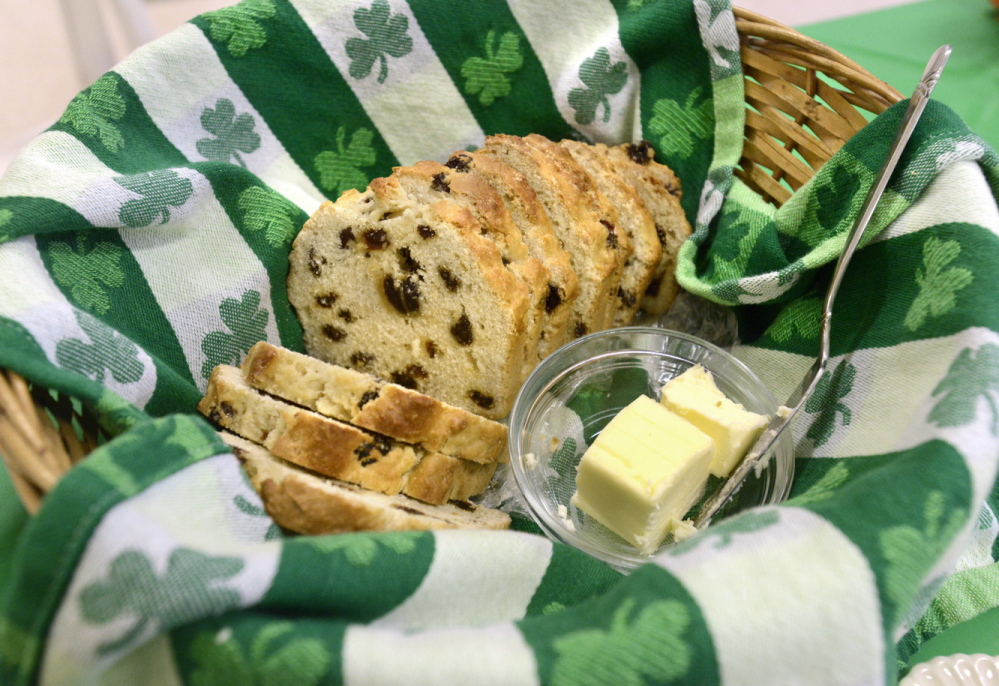
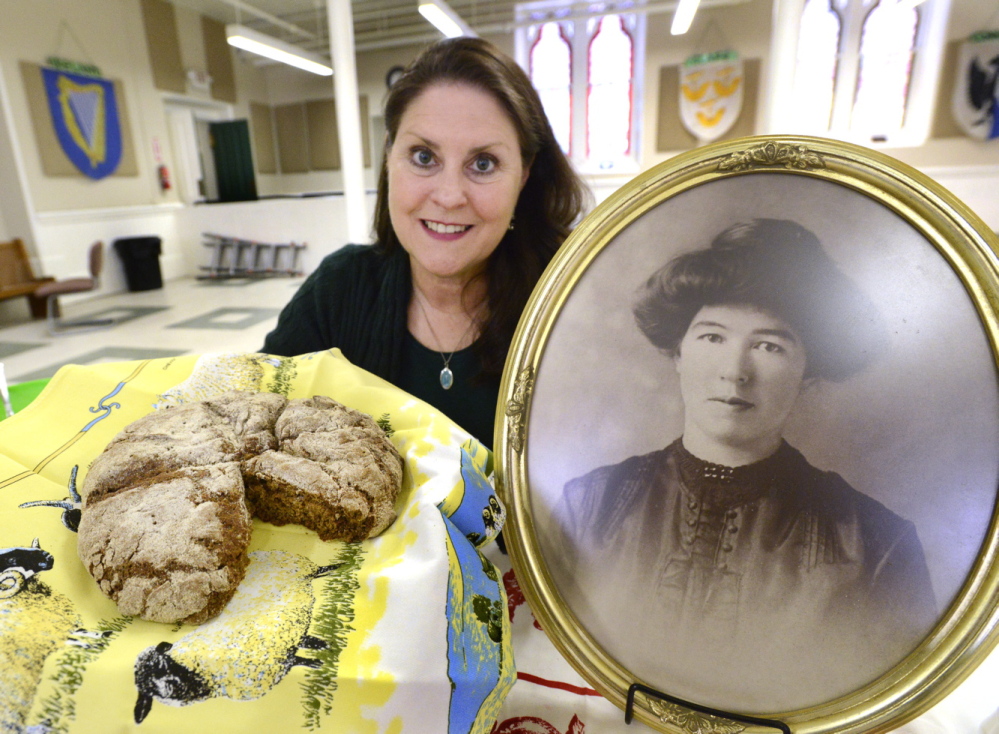
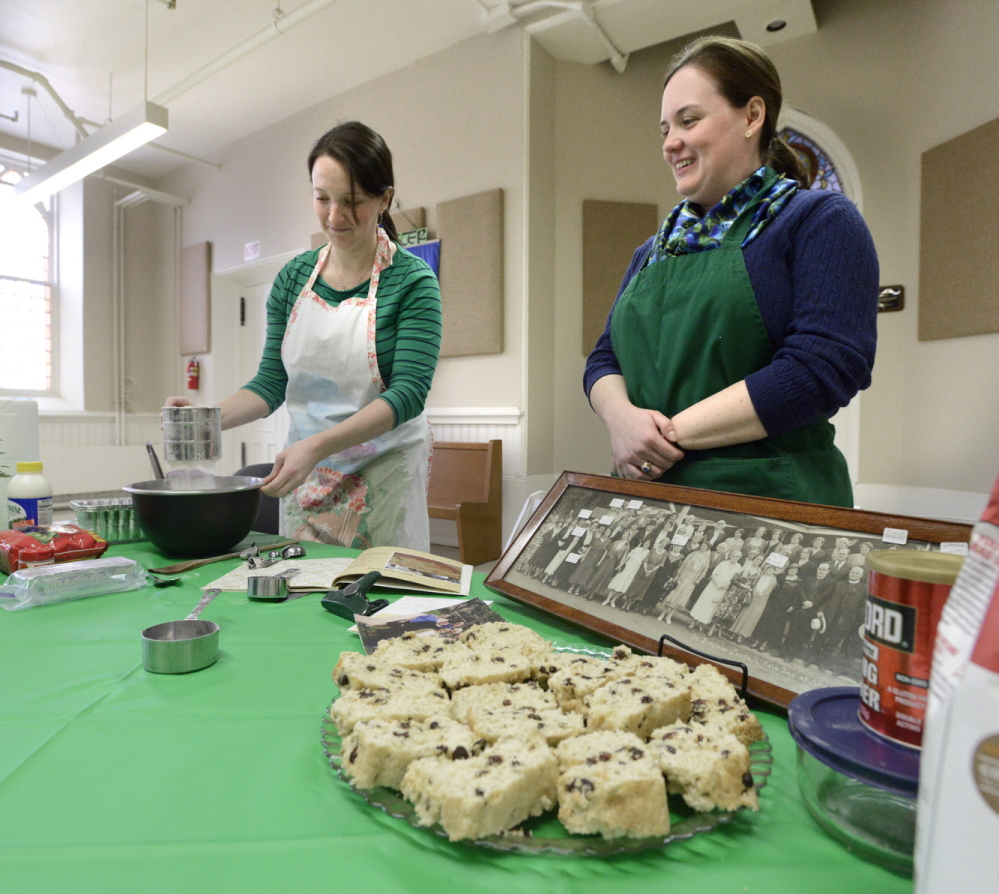
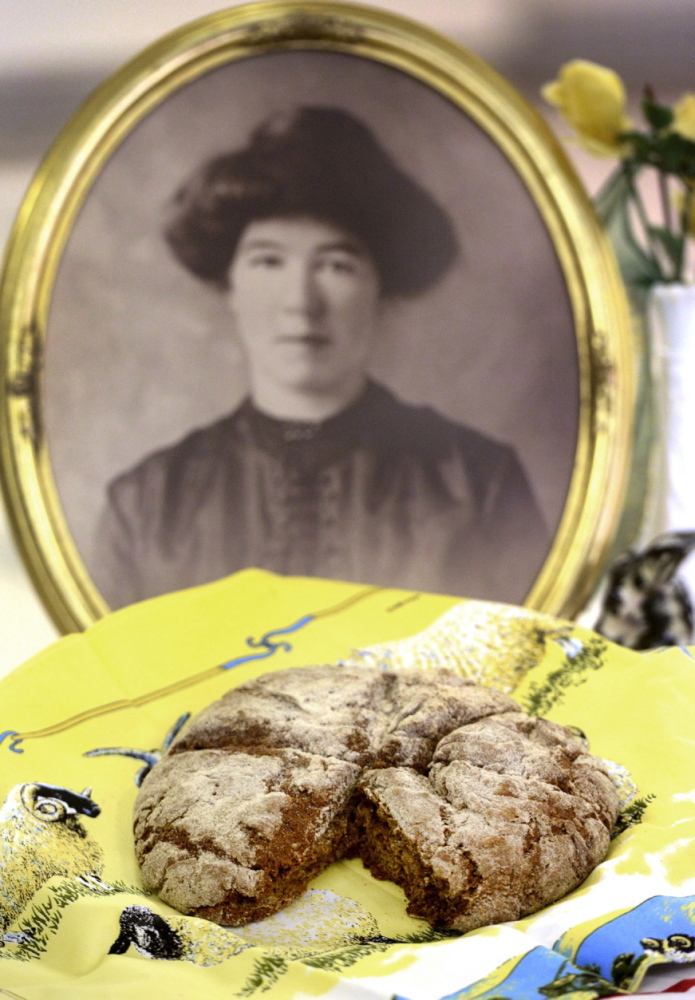
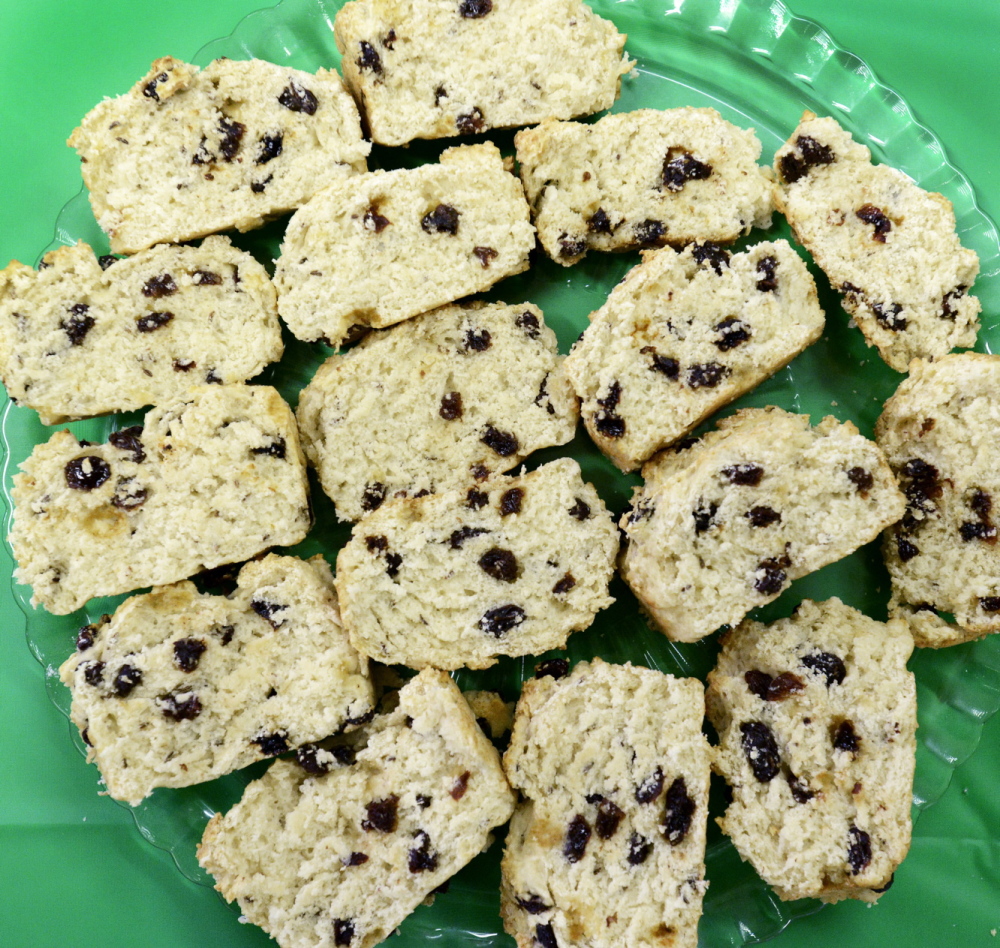

Success. Please wait for the page to reload. If the page does not reload within 5 seconds, please refresh the page.
Enter your email and password to access comments.
Hi, to comment on stories you must . This profile is in addition to your subscription and website login.
Already have a commenting profile? .
Invalid username/password.
Please check your email to confirm and complete your registration.
Only subscribers are eligible to post comments. Please subscribe or login first for digital access. Here’s why.
Use the form below to reset your password. When you've submitted your account email, we will send an email with a reset code.